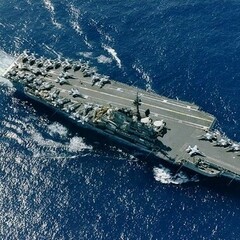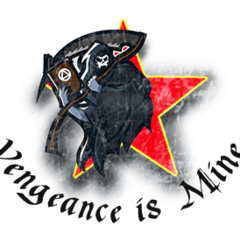-
Posts
369 -
Joined
-
Last visited
About Yoda967
- Birthday 07/13/1961
Personal Information
-
Flight Simulators
DCS (obviously), MSFS
-
Location
London, UK
Recent Profile Visitors
4731 profile views
-
Authentikit is reportedly working with Flying Iron Simulations on an F6F throttle.
-
The jet defaults to Zulu time on the HUD and local time on the IFEI (which also displays fuel state and engine status). To set local time on the HUD, go to the HSI on one of your MFDs or the AMPCD. Press PB17 (lower row of push buttons, second from the right) to box TIMEUFC. On the Up Front Controller press the bottom OSB to select LTOD with a colon. Now, when the aircraft is airborne, the HUD will display local time. On the IFEI, local time is the default setting, but you can toggle between local and Zulu time by pressing the "zone" button.
-
I've met both, too. I'd like to think I was one of the good ones. I have certainly experienced the feeling of not knowing where to start in DCS. You're absolutely right about the learning curve; I've been a flight simmer since the mid-80s, and it's still pretty steep. As you've discovered, though, you just keep plugging away at stuff as it comes up. I am curious about what you mean when you describe a campaign as "for beginners" vs. one "to keep the pros engaged." I imagine you mean more player assists for beginner-level campaigns and more intense tactical situations for pro/varsity-level campaigns. Do I understand that correctly? (Not saying either one is preferable, just asking the question for clarity.)
-
@Raisuli, Embarrass yourself? As a Navy instructor, I used to tell my trainees that mistakes are where the learning happens. And yeah, I know *you* have been around with DCS enough to be able to handle yourself well, but your post raises questions that a lot of folks new to the sim are asking...some of my answer was directed at them. (And as with any advice, take what you want and disregard the parts that don't feel right to you.) Grab a campaign and go to it, man.
-
@Raisuli, @Mistermann puts up some great advice, and I would add that if you're not feeling comfortable in the Hornet yet, make yourself some very simple missions that let you focus on a single task (like AAR or Case I or Case III recoveries). The simpler your practice, the better. Isolate the task, and until you've achieved consistent success (80% or better), don't try to do it inside a full mission. When folks new to the Hornet ask about how to land on the carrier, I always point them to a fixed runway first and tell them to practice landings in the proper configuration with the runway touchdown markers as their aim point. When they can hit the touchdown markers on centerline every time, they're ready to try a landing on the boat. The very first DLC campaign mission I ever flew was the first mission of Groundpounder Sims' FIWOS, which calls for you to approach a SAM site at below 500 feet and execute a pop-up attack. I'm not an F-16 guy...it's a nice jet, but I'm all Navy and the Hornet is my go to. Still, I shacked that Fan Song like a pro. (And then I blew the landing after pressing a bad approach instead of going around.) Point is: just get a campaign from one of the good developers and work your way through. If that's too intimidating (and I get it), then read the first mission briefing, break down what will be expected of you, and create a practice mission for each mission task you expect. Just do it. You're as safe as chairs.
-
If you're looking for carrier-based F/A-18 missions, try the Raven One campaigns by Baltic Dragon. If you don't particularly want to fly from a carrier, then Operation Cerberus North by Chillng is fantastic. The documentation in Cerberus North is a work of art, with almost 100 pages of supporting docs in addition to a briefing doc for each mission. All three campaigns have strong stories, which add immensely to the immersion.
-
This.
-
Having been a CIWS tech during its earliest days in the fleet, I can attest to this being the mindset at the time. As a former CIWS instructor, I can say that no, they do not have a "mind of their own", they operate exactly how they were designed to (barring a failure -- more about that in a moment). The biggest operational problem with them was that many COs did not understand them. I will add that in my experience, military decision-makers tend to be risk-averse, especially when there are systems involved that are poorly understood. That was most certainly the case in the 80s, and made the bogus "meaning" of the acronym ("Captain, It Won't Shoot") that much more insulting to those of us who maintained and operated it. In STARK's case, the CIWS was not operating because they were running electrical power-affecting engineering drills at the time. According to an old CO of mine who had commanded an FFG in the Gulf during the Iran/Iraq War, it was commonplace for Iraqi F-1s to overfly US warships on their way to their targets. It may seem hard to believe now, but Iraq was considered an ally at the time, so such overflights were accepted, even if they weren't particularly comfortable. The JARRETT/MISSOURI friendly-fire incident didn't do much to assuage concerns. Eventually, the Navy developed doctrine that was effective in preventing issues like these, which is why we're not talking about similar incidents in the last 30-odd years. Now, a sea-story involving a failure: This happened during a firing exercise being conducted to impress some distinguished visitors with the power of our Phalanx systems. I was at the local control panel, and would be firing the gun from my position after being cleared by the skipper. The procedure was 1) receive clearance while gun was in stowed position, 2) energize the gun mount and move it to the pre-assigned firing bearing off the port beam at 45 degrees elevation, 3) fire a 100-round burst. What happened was: 1) I received clearance to fire, 2) I energized the gun and set it to move to the firing bearing and elevation, 3) the rate integrating gyro failed, causing the gun to slew to the physical stops aft of the port beam at 45 degrees elevation -- which left the visitors and the skipper in his whites standing on the port bridgewing staring directly into the muzzle of the gun and diving for the deck, and 4) yours truly recognizing the error and powering the mount down where it was. (It is worth noting that the PHYSICAL mount stops are outside the ELECTRICAL firing circuit stops. The gun was not going to fire because the firing circuit gets broken if the gun is pointed at any part of the ship's structure. I shut it down because the gun hadn't gone where I expected it to.) As @Northstar98 rightly points out, RL screen formations look nothing like the close-in stuff you typically see in DCS missions and cinematics, though this is not entirely because of CIWS. It's mostly a safety of navigation issue. Look up the MELBOURNE/EVANS incident, in which an Aussie carrier collided with a US destroyer. CO's Standing Orders on the cruiser I served in were to remain at a safe distance from the carrier at all times (1 mile if astern of the carrier, 2 miles if abeam of the carrier, 3 miles if ahead of the carrier), going closer only with the CO's express permission, such as taking station as CV Shotgun or plane guard. The CO who wrote those orders went on to be a Carrier Group commander and after a destroyer maneuvered too close to the carrier, he summoned the destroyer's CO to the carrier and fired him on the spot.
-

Stop following command broken
Yoda967 replied to algherghezghez's topic in Aircraft AI Bugs (Non-Combined Arms)
Thanks, algherghezghez and Reflected. I forgot that it was an MT thing and spent the afternoon racking my brain because I couldn't get the mission to fail. Naturally, I wasn't testing in MT (trying to cut a corner). -

Stop following command broken
Yoda967 replied to algherghezghez's topic in Aircraft AI Bugs (Non-Combined Arms)
@Reflected has talked about this because it's also happening in his campaigns, as well, so maybe he can chime in with the symptoms he's aware of. I've noticed it in my mission development, too. What I'm seeing is that once an AI aircraft begins a follow task, it will continue until the aircraft being followed lands or is destroyed. DCS appears to be ignoring the Last Waypoint setting within the Follow command, and it will also not respond to a triggered Switch Waypoint task. Switch Waypoint appears to be working prior to any Follow command. I'll add a track file later today. -
@Rolds A workaround: When you put together an AAR training mission in the ME (or edit one), reduce your Hornet's internal fuel by 2,200 lbs for each external tank. The Hornet's external tanks feed its internals, and they'll transfer their fuel fairly quickly if the jet's internal tanks have room.
-

Hidden Achievement...
Yoda967 replied to ChillNG's topic in A-10C Operation Persian Freedom Campaign
Did two deployments to the Gulf. The "ground beef" we got from local suppliers was orange. Tasted okay, but even so, we called them "camel burgers". -
@Fuujin To add to what @Dragon1-1 has said, while you might be able to penetrate the defenses of a CSG, simply penetrating the defenses is by no means a guarantee of sinking even the escorts. DCS' damage modelling for naval units is incomplete. For a good sense of what a carrier could withstand in WWII, I recommend researching USS FRANKLIN (CV-13). She was roughly a third of a modern carrier's tonnage, and lacked the modern design elements of modern-day warships, yet she withstood more than 3 1/2 hours of secondary explosions as her own ammunition and aircraft fuel supplies cooked off...more than 55 secondaries. She still returned to San Francisco under her own power from the coast of Japan. You cannot discount the value of the crew's damage control efforts. I'd expect a modern US carrier to be still more survivable. I recommend taking a look at the articles and scenarios presented at https://www.admiraltytrilogy.com/. Their Naval Sitrep magazine is a treasure trove of solid, technical and tactical detail.
-
Fredrik, I strongly recommend the F/A-18C Kneeboard Suite, which is available in this thread:
- 1 reply
-
- 1
-







